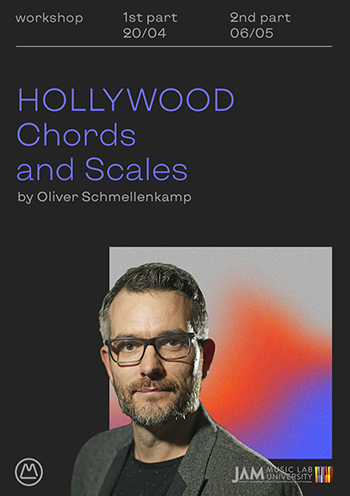
- days
- hours
- minutes
Workshop: HOLLYWOOD — CHORDS AND SCALES
It has long wanted to understand and answer the question: how to write contemporary music for the film, and what this approach is different from working with pop music? Then, in our two-day master class, together, we will try to find answers to most of the questions.
Master class lecturer: Oliver Schmellenkamp
Oliver is one of Austria's leading music composers and lecturer at the Jam Music Lab University, Vienna. He has extensive experience in cooperation with international companies, brands, media and gaming companies, including American TV channels Fox, National Geographic, German ZDF, hundreds of soundtracks for Xbox and Nintendo, as well as brands Pepsi, CocaCola, Ford, Boss, McDonald's, AirBerlin and many others.
Details:
2 lessons of 4 hours
Dates: April 20 | May 6
Start: 11:00 - morning
Format: online
Required: homework
Master class language: English
Number of seats: 15
In this master class:
1. Improve your knowledge of musical theory, emotional and chromatic harmony and how to apply this in practice.
2. Let's return for a while to the past, to the music of composers Strauss, Wagner and Stravinsky, to see what techniques can be borrowed from them and used in our time. Let's explore contemporary composers' approach: Hans Zimmer, Max Richter and Steve Jablonski and their musical material work.
3. Using the examples of well-known films, including Star Wars, iRobot, Ghostbusters, Arrival and many others, we will learn how, using a modern approach to writing music, using the knowledge gained on the course, to compose musical landscapes, which I will help to complement and reveal the events taking place on the screen.
While someone dreams of winning an Oscar and writing the script for a film, improve your knowledge and write a future hit in the world of soundtracks. See you at the master class!
Lessons program
Warm-Up
I wouldn't say I like it when music theory turns into rocket science; I will keep it simple as far as possible. In the warm-up, we will talk about some basics that are important for this course.
Everything else I will explain (step by step) in the following chapters.
- Triads
- Scales
- Composers Piano
1. Emotional Harmony
this chapter takes an emotional look at the diatonic triads on the major and minor scales.
In examples from Hans Zimmer, Max Richter, Steve Jablonsky and Alan Silvestri, we cover how Diatonic Triads can be used to reach the listener's heart.
Composing with Major Scale
- Diatonic Triads
- Emotional Concept
- Harmonizing a Melody
Case Studies
- Gladiator
- Express
Composing with Minor Scale
- Diatonic Triads
- Emotional Concept
- Harmonizing a Melody
Case Studies
- Arrival
- Dark Knight
- Transformers
Orchestration/Scoring Tipp
To Picture
2. Magic Modes
The modes are an important part of a composer's toolbox; each mode represents its own world with its specific associations and narratives.
We have already discussed major and minor scales; now, let's look at the other modes.
We see examples from films like Da Vinci Code, Simpsons, Back to the Future, Indiana Jones and Star Wars.
The Lydian Mode - About fairytales and mermaids
- The Lydian scale and chords
- Composing with the mode
Case Studies
- Back to the Future
- Simpsons
- Universal Logo
- ET - Little Mermaid
The Dorian Mode - About pirates and the middle ages
- The Dorian scale and chords
- Composing with the mode
Case Studies
- American Beauty
- Star Wars
- Pirates of The Caribbean
The Phrygian Mode - About the desert and mummies
- The Phrygian scale and chords
- The Phrygian dominant scale
- Composing with the mode
- Double Harmonic
Case Studies
- The Mummy
- Lawrence of Arabia
- Stargate
The Mixolydian Mode - About crowdy city and mystical
- The Mixolydian scale and chords
- Mixolydian b13
- Composing with the mode
Case Studies
- Hotel For Dogs
- Ghostbusters?
- The Locrian Mode – Dark and Heavy
The Locrian scale and chords
- Mix the Modes
- it is possible to mix the modes or to move from one mode to another.
3. Chromatic
The chromatic harmony stands for the supernatural, the wonderful, the mysterious, the mystical and the fairytale,
and goes back to the composer of the 19th and 20th centuries like Mahler, Holst, Wagner, Strauss and Stravinsky.
We can put a major or minor chord on every step of the chromatic scale with this concept.
Chromatic Mediants
- Composing with Chromatic Mediants
- The Common Tone
Case Studies
- Atlantis
- iRobot
- Lord of The Rings
- Star Wars
- Orchestration/Scoring Tipp
- To Picture
- Tritone Relationship
- Composing with Tritone Related Chords
- Motifs and Melodies
Case Studies
- Indiana Jones
- iRobot
- Star Wars
- Orchestration/Scoring Tipp
- To Picture
Two Chord Relationships - The Shortcuts for Film Composer
- Chords and Narratives
I-I I-II I-III I-IV I-V I-VI I-VII
- String Theory
Case Studies
- Universal Logo
- iRobot
- Atlantis
4. Harmonic Direction
In film music, there are several possibilities to move from one chord to another. Each of these possibilities has its own sound.
- Progression
- Parallel
- Connection and Transformation
- String Theory
Orchestration/Scoring Tipp
- Developing melodies
- Motivic development
5. Chords and Colors
In this episode, we see which chords (besides triads) composers like John Williams, Danny Elfman and Bernard Hermann use,
to express different emotions.
- Hitchcock Chord
- The b13 Sound
- Cluster
- Poly Chords
- The Star Wars Chord
- John Williams Brass Triads
- Add Notes
- Compound Chords
- Diminished Transformation
- Pedals
6. Fancy Scales
Not only the modes are used by film composers, but other scales are used in certain situations. Here is a small overview.
- Synthetic Scales
- Octatonic
- Whole Tone
Case Studies
- Back to the Future
- Ghostbusters
